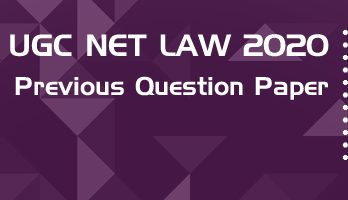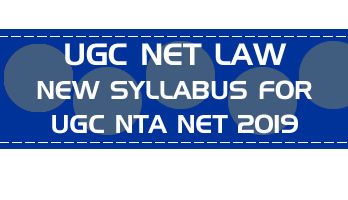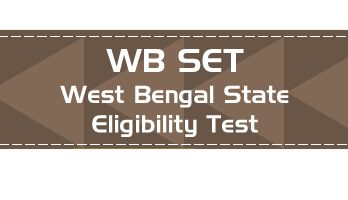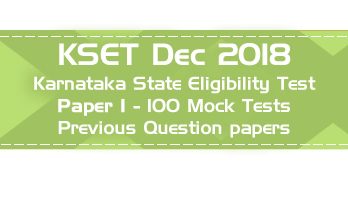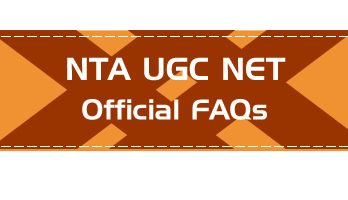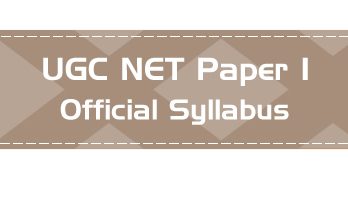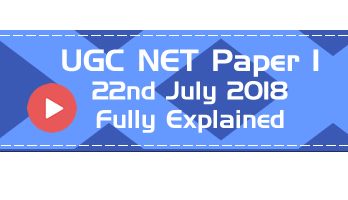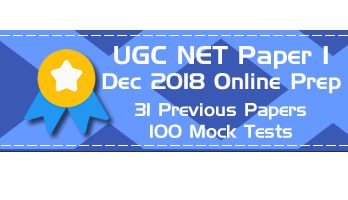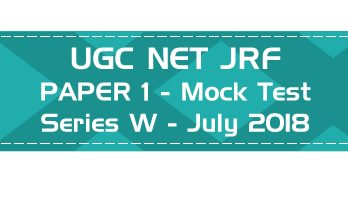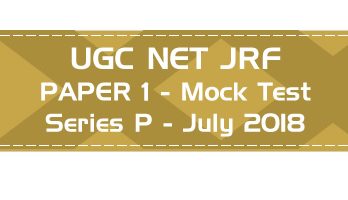- Latest Pattern Mock Tests including comprehension based questions
- Previous Question Papers with Answer Keys - From 2004 till the most recent exam
- 75 Full Length Mock Tests - New Pattern Paper II, with 100 questions each
- 50 Mini Practice Mock tests - with 25 questions each
- Unlimited Practice - New Questions in every attempt of all mocks
- Questions & Answer Choices randomly shuffled in every attempt for better practice
- Database of over 11000+ MCQs covering the entire syllabus
- Unlimited access and practice for one year from the date of purchase
- Accessible 24 x 7 via Smart-Phone browsers and Desktops
Authentic Feedback from previous LawMint users :
I got AIR 21 in CLAT PG. Thank you so much. Your mocks helped me a lot in my preparation 🙂 - Ayushi Jain
I have subscribed to your CLAT PG program and got AIR 36 in this year CLAT PG. I have also secured AIR 54 in AILET PG exam. I would like to thank you. Your mock paper really helps a lot - Shrashank Tripathi
I would like to thank you for the CLAT PG LLM COURSE. Practising mock tests there helped me in getting confidence and hence I was able to get AIR 45 in CLAT PG LLM - Akshay Awasthi
A year back, I relied on the IIT Kharagpur RGSOIPL mock test series by LawMint to prepare for my RGSOIPL entrance test. Few months back, I relied on your UGC NET Law series to prepare for UGC NET. I was the topper of the RGSOIPL entrance, and have cracked JRF in UGC NET. All thanks to LawMint - Anshuman Sahoo
"I got AIR 18 in CLAT PG and General Category rank 28 in AILET PG. I want to thank you for helping me practice well in controlled conditions from any place. It gave me a lot of confidence and I took the tests while travelling too. I also made it to IIT Kharagpur." - Vinodharani
"Lawmint has been of great help to me in securing AIR 25 in AILET PG and AIR 29 in CLAT PG examinations. The subjective and objective approach of the test series kept me up to date with the latest exam pattern." - Bhawna Nanda
"I, Nimmy Saira Zachariah joined you clat test series. I cleared AILET PG with 30th rank. Your test series were of immense help as it gave me clear idea of where my preparations stand thank you once again law mint." - Nimmy S Z
"Hey guys. Where do I start? If I thought that getting AIR 59 in Clat PG was it, then how wrong I was. With Lawmint now I have cracked UGC NET as well." - Joyanta Chakraborty
Note : Answer Keys to all Previous Question Papers published on LawMint are available to registered users of LawMint.com Online Practice Packs.
Check out all the HECI NTA NET or UGC CBSE NET Paper 1 previous question papers here : Previous Papers & Mock Tests
Note : UGC has rolled out a revised syllabus for both Papers 1 & 2 from Jan 2019 onward.
1. Verbal guidance is least effective in the learning of:
– Aptitudes
– Skills
– Attitudes
– Relationship
2. Which is the most important aspect of the teacher’s role in learning?
– The development of insight into what constitutes an adequate performance
– The development of insight into what constitutes the pitfalls and dangers to be avoided
– The provision of encouragement and moral support
– The provision of continuous diagnostic and remedial help
3. The most appropriate purpose of learning is:
– personal adjustment
– modification of behaviour
– social and political awareness
– preparing oneself for employment
4. The students who keep on asking questions in the class should be:
– encouraged to find answer independently
– advised to meet the teacher after the class
– encouraged to continue questioning
– advised not to disturb during the lecture
5. Maximum participation of students is possible in teaching through:
– discussion method
– lecture method
– audio-visual aids
– text book method
6. Generalised conclusion on the basis of a sample is technically known as:
– Data analysis and interpretation
– Parameter inference
– Statistical inference
– All of the given choices
7. The experimental study is based on:
– The manipulation of variables
– Conceptual parameters
– Replication of research
– Survey of literature
8. The main characteristic of scientific research is:
– empirical
– theoretical
– experimental
– all of the above
9. Authenticity of a research finding is its:
– Originality
– Validity
– Objectivity
– All of the given choices
10. Which technique is generally followed when the population is finite?
– Area Sampling Technique
– Purposive Sampling Technique
– Systematic Sampling Technique
– None of the given choices
11. Read the following passage and answer the question :
Gandhi’s overall social and environmental philosophy is based on what human beings need rather than what they want. His early introduction to the teachings of Jains, Theosophists, Christian sermons, Ruskin and Tolstoy, and most significantly the Bhagavad Gita, were to have profound impact on the development of Gandhi’s holistic thinking on humanity, nature and their ecological interrelation. His deep concern for the disadvantaged, the poor and rural population created an ambience for an alternative social thinking that was at once far-sighted, local and immediate. For Gandhi was acutely aware that the demands generated by the need to feed and sustain human life, compounded by the growing industrialization of India, far outstripped the finite resources of nature. This might nowadays appear naive or commonplace, but such pronouncements were as rare as they were heretical a century ago. Gandhi was also concerned about the destruction, under colonial and modernist designs, of the existing infrastructures which had more potential for keeping a community flourishing within ecologically-sensitive traditional patterns of subsistence, especially in the rural areas, than did the incoming Western alternatives based on nature-blind technology and the enslavement of human spirit and energies.
Perhaps the moral principle for which Gandhi is best known is that of active non-violence, derived from the traditional moral restraint of not injuring another being. The most refined expression of this value is in the great epic of the Mahabharata, (c. 100 BCE to 200 CE), where moral development proceeds through placing constraints on the liberties, desires and acquisitiveness endemic to human life. One’s action is judged in terms of consequences and the impact it is likely to have on another. Jainas had generalized this principle to include all sentient creatures and biocommunities alike. Advanced Jaina monks and nuns will sweep their path to avoid harming insects and even bacteria. Non-injury is a non-negotiable universal prescription.
Which one of the following have a profound impact on the development of Gandhi’s holistic thinking on humanity, nature and their ecological interrelations?
– Jain teachings
– Christian sermons
– Bhagavad Gita
– Ruskin and Tolstoy
12. Read the following passage and answer the question :
Gandhi’s overall social and environmental philosophy is based on what human beings need rather than what they want. His early introduction to the teachings of Jains, Theosophists, Christian sermons, Ruskin and Tolstoy, and most significantly the Bhagavad Gita, were to have profound impact on the development of Gandhi’s holistic thinking on humanity, nature and their ecological interrelation. His deep concern for the disadvantaged, the poor and rural population created an ambience for an alternative social thinking that was at once far-sighted, local and immediate. For Gandhi was acutely aware that the demands generated by the need to feed and sustain human life, compounded by the growing industrialization of India, far outstripped the finite resources of nature. This might nowadays appear naive or commonplace, but such pronouncements were as rare as they were heretical a century ago. Gandhi was also concerned about the destruction, under colonial and modernist designs, of the existing infrastructures which had more potential for keeping a community flourishing within ecologically-sensitive traditional patterns of subsistence, especially in the rural areas, than did the incoming Western alternatives based on nature-blind technology and the enslavement of human spirit and energies.
Perhaps the moral principle for which Gandhi is best known is that of active non-violence, derived from the traditional moral restraint of not injuring another being. The most refined expression of this value is in the great epic of the Mahabharata, (c. 100 BCE to 200 CE), where moral development proceeds through placing constraints on the liberties, desires and acquisitiveness endemic to human life. One’s action is judged in terms of consequences and the impact it is likely to have on another. Jainas had generalized this principle to include all sentient creatures and biocommunities alike. Advanced Jaina monks and nuns will sweep their path to avoid harming insects and even bacteria. Non-injury is a non-negotiable universal prescription.
Gandhi’s overall social and environmental philosophy is based on human beings’:
– need
– desire
– wealth
– welfare
13. Read the following passage and answer the question :
Gandhi’s overall social and environmental philosophy is based on what human beings need rather than what they want. His early introduction to the teachings of Jains, Theosophists, Christian sermons, Ruskin and Tolstoy, and most significantly the Bhagavad Gita, were to have profound impact on the development of Gandhi’s holistic thinking on humanity, nature and their ecological interrelation. His deep concern for the disadvantaged, the poor and rural population created an ambience for an alternative social thinking that was at once far-sighted, local and immediate. For Gandhi was acutely aware that the demands generated by the need to feed and sustain human life, compounded by the growing industrialization of India, far outstripped the finite resources of nature. This might nowadays appear naive or commonplace, but such pronouncements were as rare as they were heretical a century ago. Gandhi was also concerned about the destruction, under colonial and modernist designs, of the existing infrastructures which had more potential for keeping a community flourishing within ecologically-sensitive traditional patterns of subsistence, especially in the rural areas, than did the incoming Western alternatives based on nature-blind technology and the enslavement of human spirit and energies.
Perhaps the moral principle for which Gandhi is best known is that of active non-violence, derived from the traditional moral restraint of not injuring another being. The most refined expression of this value is in the great epic of the Mahabharata, (c. 100 BCE to 200 CE), where moral development proceeds through placing constraints on the liberties, desires and acquisitiveness endemic to human life. One’s action is judged in terms of consequences and the impact it is likely to have on another. Jainas had generalized this principle to include all sentient creatures and biocommunities alike. Advanced Jaina monks and nuns will sweep their path to avoid harming insects and even bacteria. Non-injury is a non-negotiable universal prescription.
Gandhiji’s deep concern for the disadvantaged, the poor and rural population created an ambience for an alternative:
– rural policy
– social thinking
– urban policy
– economic thinking
14. Read the following passage and answer the question :
Gandhi’s overall social and environmental philosophy is based on what human beings need rather than what they want. His early introduction to the teachings of Jains, Theosophists, Christian sermons, Ruskin and Tolstoy, and most significantly the Bhagavad Gita, were to have profound impact on the development of Gandhi’s holistic thinking on humanity, nature and their ecological interrelation. His deep concern for the disadvantaged, the poor and rural population created an ambience for an alternative social thinking that was at once far-sighted, local and immediate. For Gandhi was acutely aware that the demands generated by the need to feed and sustain human life, compounded by the growing industrialization of India, far outstripped the finite resources of nature. This might nowadays appear naive or commonplace, but such pronouncements were as rare as they were heretical a century ago. Gandhi was also concerned about the destruction, under colonial and modernist designs, of the existing infrastructures which had more potential for keeping a community flourishing within ecologically-sensitive traditional patterns of subsistence, especially in the rural areas, than did the incoming Western alternatives based on nature-blind technology and the enslavement of human spirit and energies.
Perhaps the moral principle for which Gandhi is best known is that of active non-violence, derived from the traditional moral restraint of not injuring another being. The most refined expression of this value is in the great epic of the Mahabharata, (c. 100 BCE to 200 CE), where moral development proceeds through placing constraints on the liberties, desires and acquisitiveness endemic to human life. One’s action is judged in terms of consequences and the impact it is likely to have on another. Jainas had generalized this principle to include all sentient creatures and biocommunities alike. Advanced Jaina monks and nuns will sweep their path to avoid harming insects and even bacteria. Non-injury is a non-negotiable universal prescription.
Colonial policy and modernisation led to the destruction of:
– major industrial infrastructure
– irrigation infrastructure
– urban infrastructure
– rural infrastructure
15. Read the following passage and answer the question :
Gandhi’s overall social and environmental philosophy is based on what human beings need rather than what they want. His early introduction to the teachings of Jains, Theosophists, Christian sermons, Ruskin and Tolstoy, and most significantly the Bhagavad Gita, were to have profound impact on the development of Gandhi’s holistic thinking on humanity, nature and their ecological interrelation. His deep concern for the disadvantaged, the poor and rural population created an ambience for an alternative social thinking that was at once far-sighted, local and immediate. For Gandhi was acutely aware that the demands generated by the need to feed and sustain human life, compounded by the growing industrialization of India, far outstripped the finite resources of nature. This might nowadays appear naive or commonplace, but such pronouncements were as rare as they were heretical a century ago. Gandhi was also concerned about the destruction, under colonial and modernist designs, of the existing infrastructures which had more potential for keeping a community flourishing within ecologically-sensitive traditional patterns of subsistence, especially in the rural areas, than did the incoming Western alternatives based on nature-blind technology and the enslavement of human spirit and energies.
Perhaps the moral principle for which Gandhi is best known is that of active non-violence, derived from the traditional moral restraint of not injuring another being. The most refined expression of this value is in the great epic of the Mahabharata, (c. 100 BCE to 200 CE), where moral development proceeds through placing constraints on the liberties, desires and acquisitiveness endemic to human life. One’s action is judged in terms of consequences and the impact it is likely to have on another. Jainas had generalized this principle to include all sentient creatures and biocommunities alike. Advanced Jaina monks and nuns will sweep their path to avoid harming insects and even bacteria. Non-injury is a non-negotiable universal prescription.
Gandhi’s active non-violence is derived from:
– Moral restraint of not injuring another being
– Having liberties, desires and acquisitiveness
– Freedom of action
– Nature-blind technology and enslavement of human spirit and energies
16. DTH service was started in the year:
– 2000
– 2002
– 2004
– 2006
17. National Press day is celebrated on:
– 16th November
– 19th November
– 21th November
– 30th November
18. The total number of members in the Press Council of India are:
– 28
– 14
– 17
– 20
19. The right to impart and receive information is guaranteed in the Constitution of India by Article:
– 19 (2) (a)
– 19(16)
– 19(2)
– 19(1) (a)
20. Use of radio for higher education is based on the presumption of:
– Enriching curriculum based instruction
– Replacing teacher in the long run
– Everybody having access to a radio set
– Other means of instruction getting outdated
21. Find out the number which should come at the place of question mark which will complete the following series: 5, 4, 9, 17, 35, ? = 139
– 149
– 79
– 49
– 69
22. This question is based on the following diagram in which there are three interlocking circles I, S and P, where circle I stands for Indians, circle S for Scientists and circle P for Politicians. Different regions in the figure are lettered from a to f
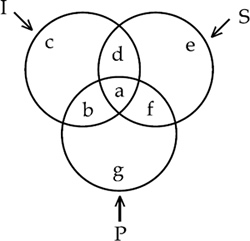
The region which represents Non-Indian Scientists who are Politicians:
– f
– d
– a
– c
23. This question is based on the following diagram in which there are three interlocking circles I, S and P, where circle I stands for Indians, circle S for Scientists and circle P for Politicians. Different regions in the figure are lettered from a to f

The region which represents Indians who are neither Scientists nor Politicians:
– g
– c
– f
– a
24. This question is based on the following diagram in which there are three interlocking circles I, S and P, where circle I stands for Indians, circle S for Scientists and circle P for Politicians. Different regions in the figure are lettered from a to f

The region which represents Politicians who are Indians as well as Scientists:
– b
– c
– a
– d
25. Which number is missing in the following series? – 2, 5, 10, 17, 26, 37, 50, ?
– 63
– 65
– 67
– 69
26. The function of measurement includes:
– Prognosis
– Diagnosis
– Prediction
– All of the given choices
27. Logical arguments are based on:
– Scientific reasoning
– Customary reasoning
– Mathematical reasoning
– Syllogistic reasoning
28. Insert the missing number: 4 : 17 :: 7 : ?
– 48
– 49
– 50
– 51
29. Choose the odd word:
– Nun
– Knight
– Monk
– Priest
30. Choose the number which is different from others in the group:
– 49
– 63
– 77
– 81
31. Probability sampling implies:
– Stratified Random Sampling
– Systematic Random Sampling
– Simple Random Sampling
– All of the given choices
32. Insert the missing number: 36/62 , 39/63, 43/61, 48/64, ?
– 51/65
– 56/60
– 54/65
– 33/60
33. At what time between 3 and 4 O’clock will the hands of a watch point in opposite directions?
– 40 minutes past three
– 50 minutes past three
– 45 minutes past three
– 55 minutes past three
34. Mary has three children. What is the probability that none of the three children is a boy?
– 1/2
– 1/3
– 3/4
– 1/8
35. If the radius of a circle is increased by 50 per cent. Its area is increased by:
– 125 per cent
– 100 per cent
– 75 per cent
– 50 per cent
36. CD ROM stands for:
– Computer Disk Read Only Memory
– Compact Disk Read Over Memory
– Compact Disk Read Only Memory
– Computer Disk Read Over Memory
37. The ‘brain’ of a computer which keeps peripherals under its control is called:
– Common Power Unit
– Common Processing Unit
– Central Power Unit
– Central Processing Unit
38. Data can be saved on backing storage medium known as :
– Compact Disk Recordable
– Computer Disk Rewritable
– Compact Disk Rewritable
– Computer Data Rewritable
39. RAM means:
– Random Access Memory
– Rigid Access Memory
– Rapid Access Memory
– Revolving Access Memory
40. www represents:
– who what and where
– weird wide web
– word wide web
– world wide web
41. Deforestation during the recent decades has led to:
– Soil erosion
– Landslides
– Loss of bio-diversity
– All of the given choices
42. Which one of the following natural hazards is responsible for causing highest human disaster?
– Earthquakes
– Snow-storms
– Volcanic eruptions
– Tsunami
43. Which one of the following is appropriate for natural hazard mitigation?
– International AID
– Timely Warning System
– Rehabilitation
– Community Participation
44. Slums in metro-city are the result of:
– Rural to urban migration
– Poverty of the city-scape
– Lack of urban infrastructure
– Urban-governance
45. The great Indian Bustard bird is found in:
– Thar Desert of India
– Coastal regions of India
– Temperate Forests in the Himalaya
– Tarai zones of the Himalayan Foot
46. The first Indian Satellite for serving the educational sector is known as:
– SATEDU
– INSAT – B
– EDUSAT
– INSAT-C
47. Exclusive educational channel of IGNOU is known as:
– GyanDarshan
– Cyan Vani
– DoorDarshan
– Prasar Bharati
48. The head quarter of Mahatma Gandhi Antarrashtriya Hindi Vishwavidyalaya is situated in:
– Sevagram
– New Delhi
– Wardha
– Ahmedabad
49. Match List – I with List – II and select the correct answer using the codes given below:
List-I – Institutes
(a) Central Institute of English and Foreign Languages
(b) Gramodaya Vishwavidyalaya
(c) Central Institute of Higher Tibetan Studies
(d) IGNOU
List-II – Locations
(i) Chitrakoot
(ii) Hyderabad
(iii) New Delhi
(iv) Dharmasala
Choose the answer that corresponds to the order (a) (b) (c) (d)
– (ii) (i) (iv) (iii)
– (iv) (iii) (ii) (i)
– (iii) (iv) (i) (ii)
– (i) (ii) (iv) (iii)
50. The aim of vocationalization of education is:
– preparing students for a vocation along with knowledge
– converting liberal education into vocational education
– giving more importance to vocational than general education
– making liberal education job-oriented
- Latest Pattern Mock Tests including comprehension based questions
- Previous Question Papers with Answer Keys - From 2004 till the most recent exam
- 75 Full Length Mock Tests - New Pattern Paper II, with 100 questions each
- 50 Mini Practice Mock tests - with 25 questions each
- Unlimited Practice - New Questions in every attempt of all mocks
- Questions & Answer Choices randomly shuffled in every attempt for better practice
- Database of over 11000+ MCQs covering the entire syllabus
- Unlimited access and practice for one year from the date of purchase
- Accessible 24 x 7 via Smart-Phone browsers and Desktops
Authentic Feedback from previous LawMint users :
I got AIR 21 in CLAT PG. Thank you so much. Your mocks helped me a lot in my preparation 🙂 - Ayushi Jain
I have subscribed to your CLAT PG program and got AIR 36 in this year CLAT PG. I have also secured AIR 54 in AILET PG exam. I would like to thank you. Your mock paper really helps a lot - Shrashank Tripathi
I would like to thank you for the CLAT PG LLM COURSE. Practising mock tests there helped me in getting confidence and hence I was able to get AIR 45 in CLAT PG LLM - Akshay Awasthi
A year back, I relied on the IIT Kharagpur RGSOIPL mock test series by LawMint to prepare for my RGSOIPL entrance test. Few months back, I relied on your UGC NET Law series to prepare for UGC NET. I was the topper of the RGSOIPL entrance, and have cracked JRF in UGC NET. All thanks to LawMint - Anshuman Sahoo
"I got AIR 18 in CLAT PG and General Category rank 28 in AILET PG. I want to thank you for helping me practice well in controlled conditions from any place. It gave me a lot of confidence and I took the tests while travelling too. I also made it to IIT Kharagpur." - Vinodharani
"Lawmint has been of great help to me in securing AIR 25 in AILET PG and AIR 29 in CLAT PG examinations. The subjective and objective approach of the test series kept me up to date with the latest exam pattern." - Bhawna Nanda
"I, Nimmy Saira Zachariah joined you clat test series. I cleared AILET PG with 30th rank. Your test series were of immense help as it gave me clear idea of where my preparations stand thank you once again law mint." - Nimmy S Z
"Hey guys. Where do I start? If I thought that getting AIR 59 in Clat PG was it, then how wrong I was. With Lawmint now I have cracked UGC NET as well." - Joyanta Chakraborty
Note : Answer Keys to all Previous Question Papers published on LawMint are available to registered users of our Online Practice Packs.
Check out all the HECI NTA NET or UGC CBSE NET Paper 1 previous question papers here : Previous Papers & Mock Tests


